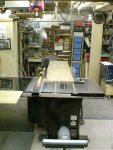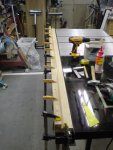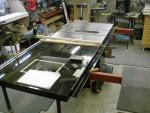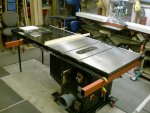Bill Lantry
Member
- Messages
- 2,663
- Location
- Inside the Beltway
Stu,
You've got a good plan for outfeed support. You've got good support to the right and left side of the blade. But what about infeed support? When I built my saw cabinet, I set it up so I could put a piece of 3/4 ply on the opened front doors. I don't use it all the time, so it's easily removeable, but it sure does come in handy (and it never falls over like roller stands do...
Thanks,
Bill
You've got a good plan for outfeed support. You've got good support to the right and left side of the blade. But what about infeed support? When I built my saw cabinet, I set it up so I could put a piece of 3/4 ply on the opened front doors. I don't use it all the time, so it's easily removeable, but it sure does come in handy (and it never falls over like roller stands do...
Thanks,
Bill


 ? Is it similar to the other Thread I've seen with the bench that uses the pipe clamps to let a board adjust up and down for support when you are working on the edges. Or can you still make the leg out of metal but for strength but wrap it in wood for your vise
? Is it similar to the other Thread I've seen with the bench that uses the pipe clamps to let a board adjust up and down for support when you are working on the edges. Or can you still make the leg out of metal but for strength but wrap it in wood for your vise

 .
.








